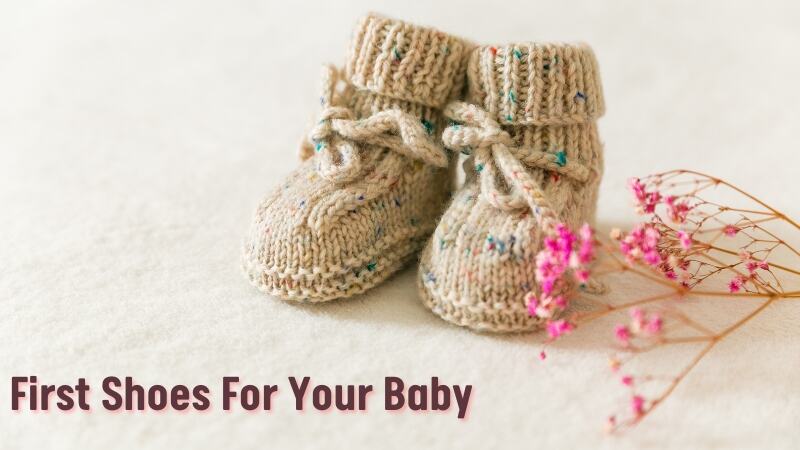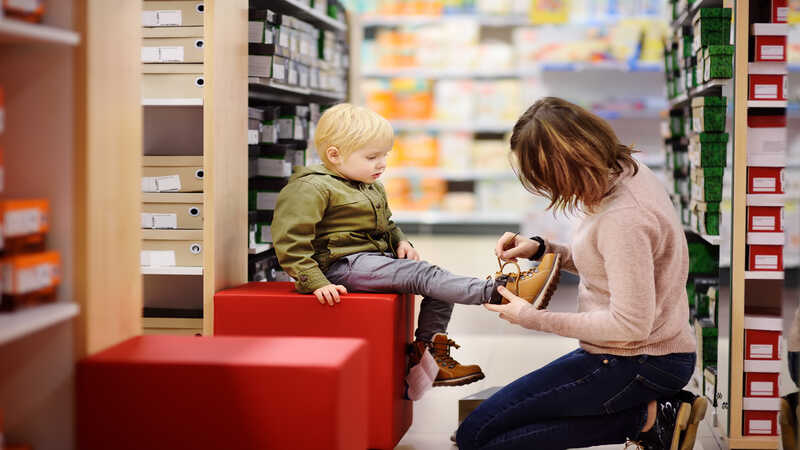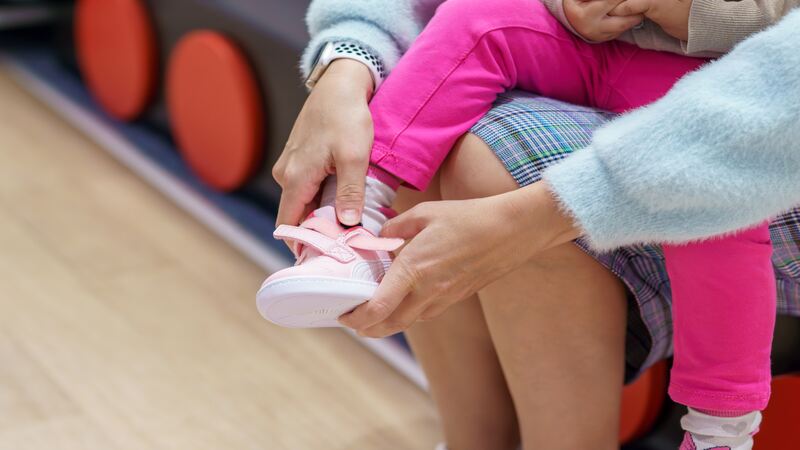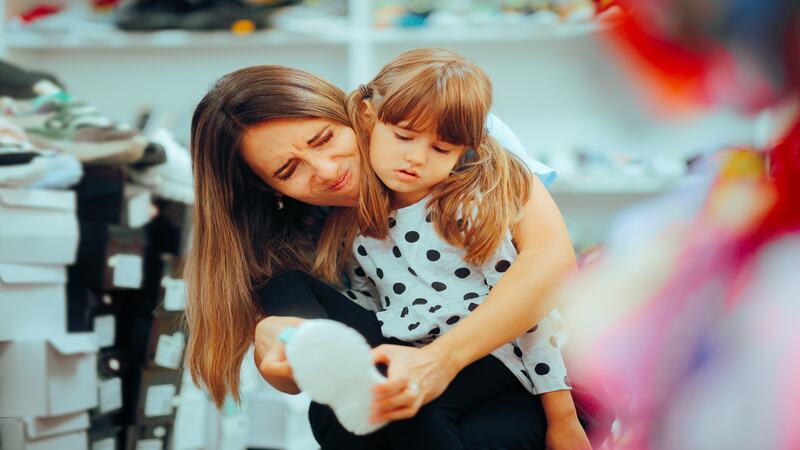
“Shoe Shopping” are two lovely words that most of us are excited to hear. Shoe shopping might be fun, but not when buying your toddler’s first pair of shoes. You’ll be surprised that such a simple thing could get a bit complicated at times—especially when you have so many things to keep in mind before buying the first pair.
As a mom, it will be not less than a war to get your toddler to try on a pair by wiggling them out of your lap without a tantrum. And even if you can get them on their feet without a lot of hassle, it can be really tricky to find out if the shoes that you have picked are of the correct size. Because most first-time moms don’t have the experience of getting one, they may find it a bit exhausting. Don’t worry, here is a complete guide on Buying Shoes For Your Toddler to help you out.
When to Get Shoes For Your Kid?
You need to get the toddlers their first pairs of shoes as soon as they start walking. As kids generally start walking around 10 to 12 months, you can think of buying shoes for your toddler during this time (1). Some parents even like to buy tiny cute booties for their newborns. However, the real use of the shoes will be when your toddler starts walking outside the house. So, go for buying shoes for your toddler just the moment they start taking baby walking steps in front of you.
Important Features to Look for in Toddler Shoes

Now that you know when to buy shoes for your toddler, it becomes important to understand what features to look into while buying them. There are certain degrees of comfort you need to ensure for your toddler while buying shoes for them. These are;
1. Wide Toe Box
The first thing you will look for in your toddler’s shoes is a wide-toe box. This will allow your kid’s little feet to expand when they try on their first steps with it.
2. Flexible Forefront
The forefront of your toddler’s shoes needs to be flexible. Because a flexible forefront will give them a grip when they hold a step forward. So ensure maximum elasticity of the forefront of the shoe.
3. Stable Heel Cup
Next forth, you need to look for a stable heel cup in your toddler’s shoes. This will ensure optimal fit and prevent accidental slips to a great extent.
4. Spongy Sole
The soles of your toddler’s shoes will provide them the ultimate comfort while walking. So ensure it is not hard for their tiny, tender feet.
Tips to Buy First Shoes For Your Toddler

Most doctors suggest that it is best to leave the kids barefoot so that they practice and perfect the art of walking. In the beginning, they tend to wobble, and having footwear might just add to the problem. At this point, it is sufficient to have a pair of socks on to keep those little feet warm. But if you’re stepping outdoors and your kid will not allow you to carry them, then you have no choice. Remember, the whole purpose of footwear is to protect those little feet from being hurt or stamped on by mistake. Don’t go too much for the looks, utility is important.
Here are some tips to make the task easier for first-timers:
- Go for breathable, lightweight material: Make sure the material is made of cloth. Leather or plastic can be stiff and won’t allow any breathing space. It may also hinder the development of the foot (2).
- Check for the soles: Make sure they are flexible and offer a good grip. They should not be smooth unless your toddler can slip. A soft rubber sole with ridges might be a good choice for toddlers (3)
- Choose Laces or Velcro: You could opt for Velcro or laces so that it can be put on and taken off easily. However, this can get a bit difficult when the toddler starts walking well and learns to take off the shoes on their own
- Padding: If possible opt for shoes that have padding at the heels and around the ankle to offer support, minimize rubbing with the skin and thus be very comfortable (4)
- Right fit: It may sound difficult, but your kid has to try the shoes on. Make sure you try on the shoes with socks on, so that you can choose the right size. The socks should be cotton, but should not be too tight and not make walking uncomfortable. Make the kids walk around with the new shoes on a bit so you can check their comfort level. If they constantly try to take it off or walk differently, you might want to try another pair.
- Shop later in the day: The best time to go shoe shopping is later in the day, preferably post-lunch as generally the legs swell and are bigger at the end of the day (5)
- Don’t buy many pairs: Little feet grow very fast, so keep checking frequently (once every month) to see if the shoe still fits well. Also, it makes sense not to invest too much in shoes at this stage, because their feet size changes by ½ rate every 2 to 3 months (6)
- Right Size: It might sound weird, but it is often noticed that most children are one foot a half size larger than the other. So, make sure you measure both the feet and go for the size that fits the larger foot
Shoes To Avoid Buying For Your Toddler

While buying shoes for your toddler you will have to be extra careful on the comfort and safety of their tiny feet. Some shoe types may not be that good for your toddler.
These are :
1. Shoes With Flat Soles
these cannot provide them with enough grip while walking. This will further increase the chances of accidental slips and falls for novice learners (7).
2. High-Heeled Shoes
your toddler girl can demand to wear high heels just like you. But make sure that the heels are not more than 2-.5cm for your toddler (8). Do not extend over 4cm heel length before your kid turns 5 years
3. Very Flat Heels
Very flat heels, like that of ballet flats, are not suitable for toddlers. Such thin flats cannot protect their feet sufficiently
4, Shoes With Pointy Toes
Pointy-toe heels can hurt the tender feet of your toddler and make it harder for them to move
5. Rubber Clogs or Jelly Clogs
These types of shoes can often react against the sensitive skin of toddlers, leading to skin irritation and rashes on the feet.
6. Sheepskin-Type Boots or Any Other Animal Skin Shoes
Some toddlers could develop allergies or sensitivities to animal materials. Also, can be heavier than other materials, making it harder for toddlers to walk and run comfortably.
Buying shoes for toddlers is not that difficult task if you know the right ways to do it. Almost all major shoe brands have a toddler version, so there is no dearth of designs to choose from. But make sure you don’t get so excited by the look of it and ignore some comfort aspects. After all, good footwear not only protects those tiny feet but also helps them to develop well and assist in walking. Don’t stress and enjoy shopping. Happy shoe hunting!
FAQ’s
1. What To Look For In First Shoes For Toddlers?
While buying shoes for toddlers you need to look for factors like the flexibility of the sole, a wide, rounded toe box, and a supportive heel cup. Lightweight velcro or strap shoes are also great for toddlers.
2. How To Choose A Shoe Size For A Toddler?
To choose a shoe size for your toddler, consider taking the measurements at the end of the day, as your kid’s feet are going to be the largest during this time. Also, take the measurements of both feet, as one foot can be bigger than the other. Buy the shoe size according to the bigger foot.
3. How Many Sizes Should You Buy Toddler Shoes?
Your toddler’ feet will grow at an exponential rate during the first 3 years of their life. You can witness nearly a half-size growth in their feet in every 2 to 3 months before 18 months (9). Therefore, consider buying 1 to 2 size extra of their actual size.
4. Should Toddlers Wear Big Shoes?
Ideally, you need to buy one to 2 size bigger shoes for your toddler if you do not want to replace them in every 2 months. But getting a much bigger size can cause instability to those fickle feet. They may fall out of losing their grip.
5. How To Tell If Toddler Shoes Fit?
To say the toddler shoe fits well, you will have to check a thumb or index finger gap between the end of the shoe and your toddler’s toe. You can also check the fit by gently tugging on the shoe and checking if it says fit.
Reference
-
- Adolph KE, Berger SE, Leo AJ. Developmental continuity? Crawling, cruising, and walking. Dev Sci. 2011 Mar;14(2):306-18. – https://www.ncbi.nlm.nih.gov/pmc/articles/PMC3050596/#
- Wang Y, Jiang H, Yu L, Gao Z, Liu W, Mei Q, Gu Y. Understanding the Role of Children’s Footwear on Children’s Feet and Gait Development: A Systematic Scoping Review. Healthcare (Basel). 2023 May 13;11(10):1418. – https://www.ncbi.nlm.nih.gov/pmc/articles/PMC10218108/#
- Williams C, Kolic J, Wu W, Paterson K. Soft soled footwear has limited impact on toddler gait. PLoS One. 2021 May 10;16(5):e0251175 – https://www.ncbi.nlm.nih.gov/pmc/articles/PMC8109762/#
- NCT, When and how to select toddler shoes – https://www.nct.org.uk/baby-toddler/your-childs-development/12-18-months/when-and-how-select-toddler-shoes#
- National Institute Of Health, Focus on Your Feet!
Take Steps to Protect Foot Health – https://newsinhealth.nih.gov/2023/03/focus-your-feet# - Gould N, Moreland M, Trevino S, Alvarez R, Fenwick J, Bach N. Foot growth in children age one to five years. Foot Ankle. 1990 Feb;10(4):211-3.– https://pubmed.ncbi.nlm.nih.gov/2307377/#
- Baker MD, Bell RE. The role of footwear in childhood injuries. Pediatr Emerg Care. 1991 Dec;7(6):353-5. – https://pubmed.ncbi.nlm.nih.gov/1788125/#
- Podiatry Care, Childrens Footwear Criteria – https://www.podiatrycare.com.au/conditions-we-treat/childrens-footwear-criteria/#
- Footwear in children. Paediatr Child Health. 2009 Feb;14(2):121-2. – https://www.ncbi.nlm.nih.gov/pmc/articles/PMC2661351/#

